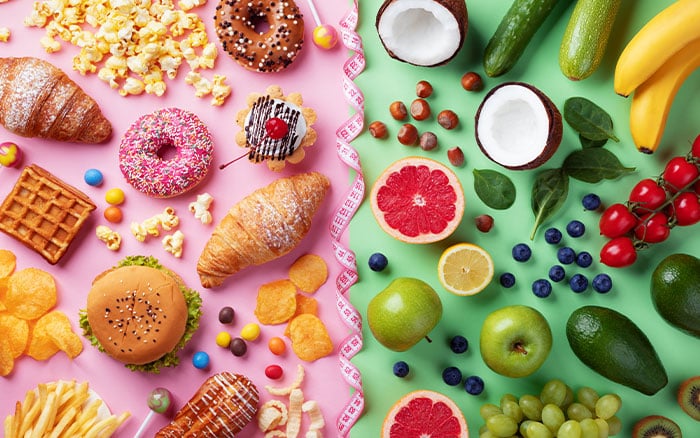As a nation, we love sugar. But it’s only in recent years that we’ve begun to question the health negatives of this indulgent ingredient. Perhaps you’ve been worried about sugar’s harm to your health and want to cut down. Well, growing your own provides you with many ways to enjoy a little sweet treat without reaching for the sugar bowl.
What are the problems with sugar?

A rare substance, sugar rose to popularity with the aristocracy in Elizabethan England. Because of its reputation as an unusual spice or medicine. By the 19th century, sugar became readily available, and Britons quickly became the largest consumers of sugar in Europe.
Having low nutritional value and high-calorie content, studies now suggest that sugar negatively impacts our dental health. And this may contribute to chronic conditions like diabetes and heart disease.
“Free sugars” are sugars that are either added to food products or that occur naturally within the food. But they have had their cellular structure broken down, for example, by blending, juicing, or powdering. Once the sugar reaches the liver, it’s processed in the same way. It turns it into droplets of fat, called triglycerides, and is distributed into the bloodstream.
This is why a high-sugar diet often leads to weight gain. But these droplets of fat also lower the good cholesterol in your system, so too much sugar can have an immeasurable effect on your health.
Can less sugar improve your health?

The NHS recommend that free sugars shouldn’t exceed 5% of total energy intake for anyone over the age of 2 years old. But do artificial and naturally occurring sugars differ in how they affect our health?
Well, the difference between them lies in the nutritional value of the food that contains sugar. For instance, innocent-looking table sugar is, in fact, heavily processed and thus contains no beneficial nutrients or fibre. This being so, it will strain your liver’s capabilities.
Additionally, foods overloaded with sugar, like sweets, chocolate, and fizzy drinks, tend to heighten your tolerance of sweet flavours over time. This leaves foods with normal sugar levels bland tasting.
For these reasons, the UK government introduced a sugar tax for fizzy drinks in April 2018. This has led over 50% of manufacturers to reformulate their drinks with sweeteners.
What sweet fresh food options are there?

Break the cycle by choosing foods, like fruits and vegetables, that offer additional fibre and vitamins alongside their sweetness.
As well as reducing sugar intake to our daily limit, a study from Harvard found that individuals who ate more than 5 servings of fruits and vegetables per day had roughly a 20% lower risk of coronary heart disease than those who didn’t.
The low-glycaemic index of many fruits and veggies also prevents blood sugar spikes and crashes. So, they could be the key to kicking those guilty pleasures and improving your overall health.
What sweet vegetable options are there?
Juicy fruits are an easy way to rack up five a day. Easy-to-grow strawberries planted by May will give you delicious, large fruits for you to enjoy in fruit salads throughout summer! But, for something to sink your sweet tooth into, turn to sweet-tasting vegetables to keep your daily portions balanced.

Look to the ever-scrumptious sweet potato for a downright winner. These little orange characters dissolved from the limelight years ago in favour of white spuds. But they’ve recently had a resurgence in popularity—and it’s about time.
Sweeter than their white potato counterparts, they’re ideal for cooking into pancakes or adding to your morning granola. Unlike other potatoes, these sweet varieties need well-drained loamy soil and love a hot, sunny spot.
Fully-grown carrots can also be pulled up, grated, and added to rice and pasta sauces for a touch of sweetness. And, by popping beetroots in the ground this month, you can make beetroot-rich chocolate muffins spiced with woody cinnamon as a late-summer indulgence.
Sweetening foods can you grow at home
Sugar substitutes
Another option is to create sweetness without any sugar at all. One plant causing a stir in this regard is Myrrhis odorata (sweet cicely) which can be used as a sugar substitute. When the seeds and dried leaves are cooked into baked goods, they add a gentle aniseed flavour.
A culinary herb, it’s best to remove flower stalks to improve the growth of the leaves. You can dry them at home in your airing cupboard.

Vegetables for baking
Blended avocado can be a cunning substitute for cream when making a chocolate mousse. It whips up nicely into a thick consistency and can be incorporated with unsweetened coco to great effect.
Avocados are easy to grow at home. But I’d recommend buying one already grafted and investing in a mature specimen for fast and abundant fruiting.
Nuts that can grow in the UK
You may also be surprised to know that hazelnuts, sweet chestnuts, and walnuts can all be grown in the UK. Whatever your soil type, there’s a nut that’ll grow in it. Established, mature trees will yield a more consistent fruit crop.
Hazel trees are the least fussy and just like a sunny spot that’s partially shaded. Almonds will also produce crops of nuts when trained against a south-facing wall.
Rich in a substance called cynarin, Cynara scolymus (globe artichokes) inhibits the taste buds that detect sweetness. When you eat or drink something that removes the cynarin, your taste buds can taste sweeter sensations than usual. So maybe you don’t need to adapt your diet, just your taste buds! Hardy varieties like ‘Vert de Laon’ have an excellent flavour and can be planted now.
A rainbow of colour will cover all your health bases. Create a harvest which has a little bit of each, and you’ll create a colourful and creative space that provides an assorted array of applications for healthy living.

Leave A Comment